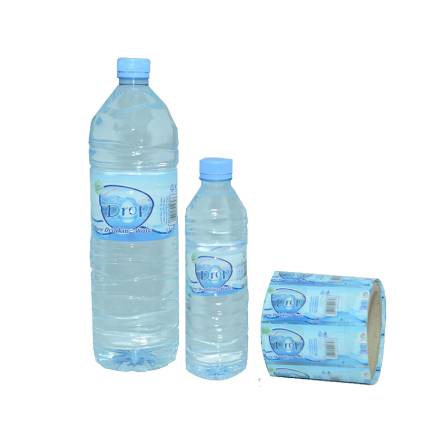Shrink labels are highly adaptable and can be decorated on packaging containers such as plastic, metal, glass, etc. Shrink Film Labels are more and more popular in the market because they can combine high-quality patterns and distinctive shapes.
Shrink film sleeve label is a kind of film sleeve label printed on plastic film or plastic tube. It has the following characteristics:
1. The shrink film sleeve label is easy to process, the package is sealed, and it is anti-pollution, and it is good for product protection;
2. The film sleeve is close to the product, the packaging is compact, and the product shape can be displayed, so it is suitable for irregular products that are difficult to pack;
3. When labeling shrink film sleeves, no adhesive is needed, and the same transparency as glass can be obtained;
4. The shrink film sleeve label can provide a 360° omni-directional decoration to the packaging container, and can print product information and other product information on the label, so that consumers can understand the performance of the product without opening the package;
5. The printing of shrink film sleeve label belongs to the printing in the film, which can protect the imprint, and the label has better abrasion resistance.

PVC Shrink Film
The design of the decorative pattern on the film set should be determined according to the thickness of the film. When designing patterns, we must first understand the horizontal and vertical shrinkage rates of the film, as well as the allowable shrinkage rates in each direction after packaging and the allowable deformation errors of the decoration patterns after shrinking, to ensure that the shrinked patterns and text can be accurately restored.
The materials used for shrink film sleeve labels should focus on three factors: environmental protection requirements, film thickness and shrinkage properties.
The basis for determining the thickness of the film is the application field and cost factors of the label. Of course, the price is not a decisive factor, because each film has its own uniqueness, users and trademark printers must clarify the film used and the most suitable material technology before signing a contract. In addition, the indicators required by the processing equipment and other process factors also directly affect the choice of thickness.
The main materials for making shrink film sleeve labels are PVC film, PET film, PETG film, OPS film, etc. Its performance is as follows:
PVC Shrink Film is currently the most widely used film material. It is inexpensive, has a large temperature shrinkage range, and does not require high heat sources. The main processing heat source is hot air, infrared rays or a combination of the two. However, PVC is difficult to recycle and produces toxic gas when burned, which is not conducive to environmental protection. Its use has been banned in Europe and Japan.
As a substitute for PVC film, OPS film has been increasingly widely used. It has good shrinkage properties and is also conducive to environmental protection. This product is in short supply in the domestic market. At present, high-quality OPS mainly relies on imports, which has become an important factor restricting its development.
PETG Shrink Film is not only good for environmental protection, but also can adjust the shrinkage rate in advance. However, due to the excessive shrinkage, it will be limited in use.
PET film is an internationally recognized environmentally friendly heat shrinkable film material. Its technical indicators, physical properties, application range and use methods are close to PVC heat shrinkable film, but the price is cheaper than PETG, and it is currently the most advanced unidirectional shrinkable film. Its transverse shrinkage rate is 70%, longitudinal shrinkage rate is less than 3%, and it is non-toxic and non-polluting. It is the most ideal material to replace PVC.
In addition, heat shrinkable film is also a material for the production of shrink film labels, and can be formed at one time without stitching in production. Compared with the horizontally flat film, the cost of producing shrink film sleeve labels with heat shrinkable film tubes is lower, but the surface printing of the tube body is more difficult to achieve. At the same time, the graphics and text of the heat-shrinkable film tube label can only be printed on the surface of the film, and the graphics and text are easy to wear during transportation and storage, which affects the packaging effect.
Shrink labels are highly adaptable, and can be used for surface decoration and decoration of packaging containers such as wood, paper, metal, glass, ceramics, etc., and are widely used in packaging and decoration of food, daily chemical products, and chemical products, such as various beverages and cosmetics. , Children's food, coffee, etc. In the field of pharmaceutical labels, paper is still the main substrate, but the development of film packaging has been rapid. At present, the key to the development of shrink film sleeve labels is to reduce costs. Only in this way can we improve our competitiveness and strive for a larger market share.
Copyright © HUBEI HYF PACKAGING CO., LTD. All Rights Reserved | Sitemap
| Powered by

SEOKeywords:Shrink Wrap Film Customized Biodegradable Shrink Film Pvc Shrink Film Rolls Flexible Packaging Film Petg Shrink Film Properties Custom Printed Shrink Film High Shrink Petg Shrink Film China Pvc Shrink Wrap Film Shrink Sleeve Plastic Label Films Shrink Sleeve Packaging Pvc Shrink Film Manufacturing Process Pvc Super Clear Shrink Film Heat Shrink Film Roll Pvc Shrink Film For Bottle Label Price Shrink Wrap Uses China Shrink Film Pvc Clear Shrink Film Printable Shrink Film Plastic Shrink Film